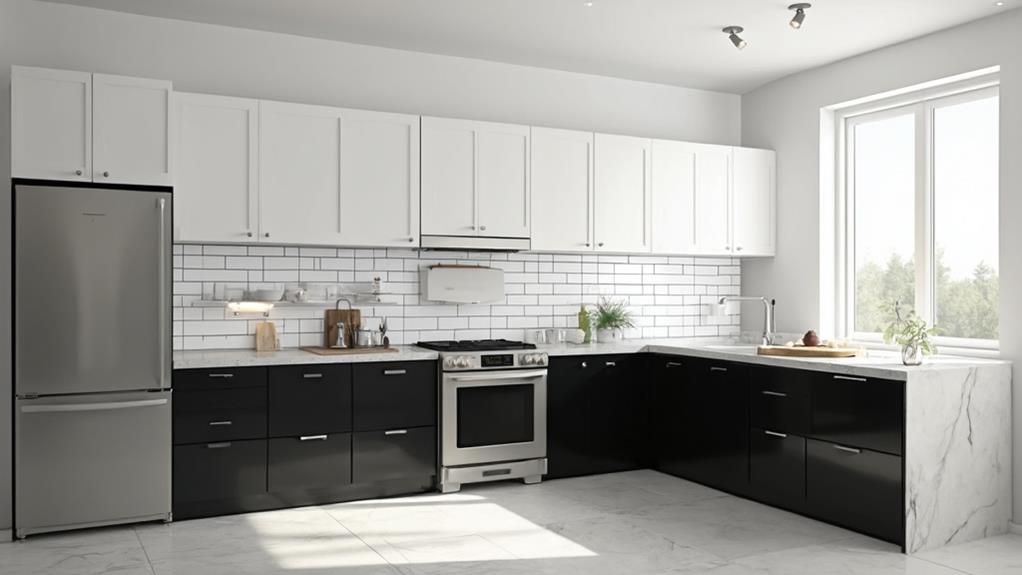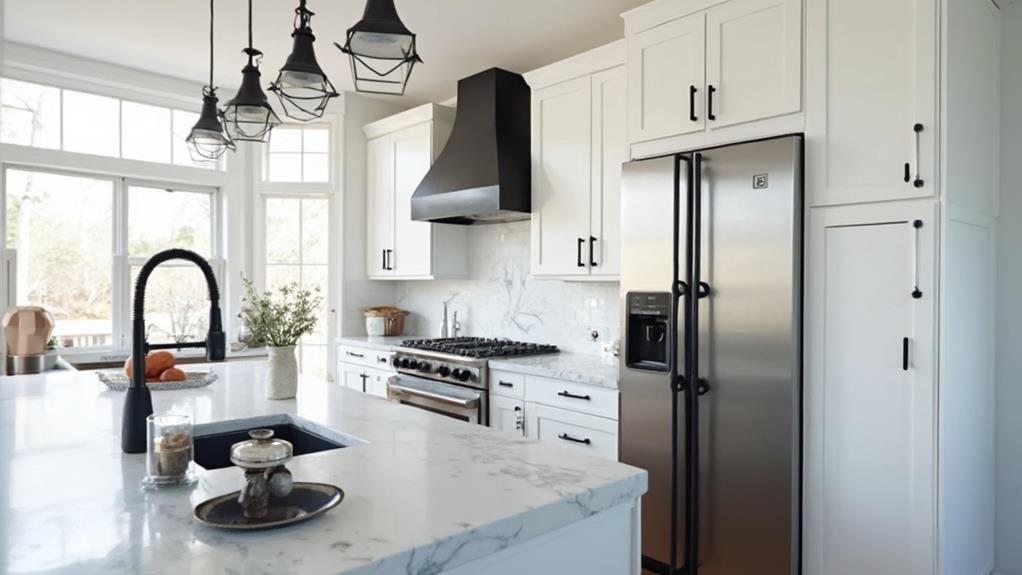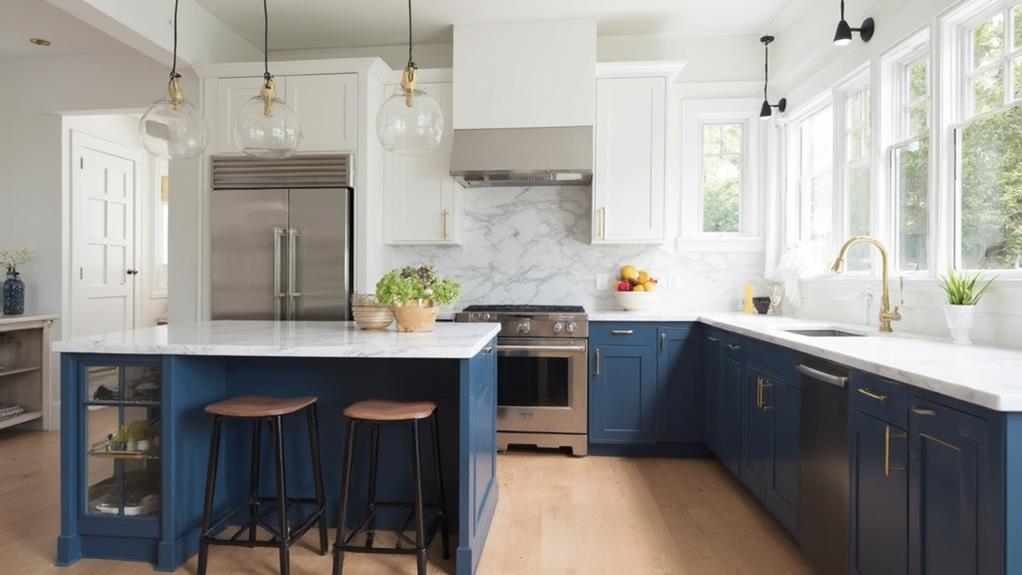To create a stunning two-tone kitchen, start by selecting a dominant color for most of the space and a complementary or contrasting color for secondary elements. Consider using lighter shades for upper cabinets and darker tones for lower cabinets to add depth. Choose wall colors and backsplashes that either match or contrast with your cabinetry. Coordinate flooring and countertops to tie the two cabinet colors together. Select appliances and hardware that complement your chosen palette. Don't forget to test colors under different lighting conditions and factor in existing decor. By following these tips, you'll be well on your way to designing a visually striking and cohesive two-tone kitchen that reflects your personal style.
Choosing Your Color Palette

Color is the foundation of any two-tone kitchen design. When choosing your palette, start by selecting a dominant color that will cover most of the space. This could be a neutral like white, gray, or beige, or a bolder hue if you're feeling adventurous.
Next, pick a complementary or contrasting color for the secondary elements. This combination will create visual interest and depth in your kitchen.
Consider the overall mood you want to achieve. Warm colors like reds and yellows can create a cozy atmosphere, while cool blues and greens promote a calm, refreshing feel. Don't forget to factor in your existing decor and the natural light in your kitchen when making your color choices.
Test your chosen colors with swatches or samples before committing. Look at them in different lighting conditions throughout the day to ensure you're happy with the combination.
Cabinets and Islands
Cabinets and islands are the centerpieces of your two-tone kitchen design. They offer the perfect opportunity to showcase your chosen color palette and create visual interest.
For upper cabinets, consider using a lighter shade to maintain an open, airy feel. Lower cabinets can feature a darker, bolder color to ground the space and add depth.
When it comes to islands, you've got options. You can match the island to your lower cabinets for a cohesive look or make it a standout feature with a contrasting color. If you're feeling adventurous, try a two-tone island with a different color on the base and countertop.
Don't forget about hardware. Choose knobs, pulls, and handles that complement both colors in your scheme. Metallic finishes like brass or chrome can add a touch of elegance and tie the two tones together.
For a subtle two-tone effect, consider using different shades of the same color family. This creates a sophisticated, monochromatic look while still adding dimension to your kitchen. Alternatively, go bold with contrasting colors for a more dramatic impact.
Walls and Backsplashes

Walls and backsplashes play a crucial role in tying your two-tone kitchen together. When selecting colors for these surfaces, consider how they'll complement or contrast with your cabinets and island. For a cohesive look, choose a wall color that matches one of your cabinet tones. Alternatively, opt for a neutral shade that allows your two-tone cabinetry to stand out.
Your backsplash offers another opportunity to introduce color or texture. You can extend one of your cabinet colors onto the backsplash for a seamless appearance, or choose a contrasting material like subway tiles, mosaic patterns, or natural stone. If you've used bold colors elsewhere, a simple white backsplash can provide balance and brightness.
Don't forget about finish options. Matte walls can create a sophisticated backdrop, while glossy tiles add depth and reflection. For added interest, consider using two different materials or patterns in your backsplash, mirroring your two-tone cabinet approach.
Remember to maintain balance in your color distribution. If one tone dominates your cabinetry, use the other color more prominently in your walls or backsplash to achieve visual equilibrium. By carefully coordinating these elements, you'll create a harmonious and striking two-tone kitchen design.
Flooring and Countertops
With your two-tone cabinets setting the stage, it's time to consider how your flooring and countertops will complement the overall design. For flooring, choose a material that contrasts with your lower cabinets while harmonizing with the overall color scheme. If you've opted for dark lower cabinets, consider light-colored hardwood or tile. Alternatively, a patterned tile can add visual interest without competing with your two-tone cabinetry.
When selecting countertops, aim for a material that ties your two cabinet colors together. If you've chosen white upper cabinets and navy lower cabinets, a marble countertop with subtle blue veining could be perfect. For a bolder look, consider a contrasting countertop color that complements both cabinet tones.
Don't forget about texture. Mix smooth surfaces with more tactile ones to add depth to your kitchen. For example, pair sleek quartz countertops with a textured tile floor. Remember to balance your choices – if your cabinets are the star, keep your flooring and countertops more subdued. Conversely, if you've chosen neutral cabinet colors, you can be more adventurous with your flooring and countertop selections. Always consider durability and maintenance requirements when making your final decisions.
Appliances and Hardware

When selecting appliances and hardware for your two-tone kitchen, how can you ensure they complement your design? First, consider the dominant colors in your kitchen and choose appliances that either match or provide a striking contrast. For example, if you've opted for white and navy cabinets, stainless steel appliances can create a sleek, modern look.
For hardware, you'll want to maintain consistency throughout the kitchen. Choose cabinet pulls, drawer handles, and faucets in the same finish to tie the design together. Brushed nickel or matte black hardware can work well with most color schemes. If you're feeling bold, consider mixing metals, such as combining brass and chrome, for a unique touch.
Don't forget about smaller appliances like toasters, coffee makers, and mixers. These can serve as accent pieces, either blending in with your color scheme or adding a pop of color. For a cohesive look, choose appliances with similar design elements or finishes. Remember, the goal is to create a harmonious balance between your two-tone cabinetry and the appliances and hardware you select. This attention to detail will result in a stunning, well-coordinated kitchen design.
Accessories and Finishing Touches
Now that you've established the foundation of your two-tone kitchen, it's time to add those final touches that will truly make the space shine. Start by selecting accessories that complement your chosen color scheme. Consider adding pops of color through small appliances, such as a vibrant stand mixer or toaster. Introduce textural elements with woven baskets, wooden cutting boards, or ceramic canisters.
Don't overlook the importance of lighting fixtures. Pendant lights or under-cabinet lighting can enhance the two-tone effect and create ambiance. Choose fixtures that echo your color palette or introduce a contrasting metallic finish.
Artwork and wall decor can tie your two-tone theme together. Hang framed prints or a statement clock that incorporates both of your chosen colors. Add warmth with textiles like curtains, seat cushions, or a stylish rug that blends your color scheme.
Conclusion
You've now got the tools to transform your kitchen into a two-tone masterpiece. Like a painter with a carefully curated palette, you're ready to breathe new life into your culinary canvas. Remember, balance is key – let your colors dance together without stepping on each other's toes. With the right combination of hues, textures, and finishes, you'll create a kitchen that's not just functional, but a feast for the eyes.

